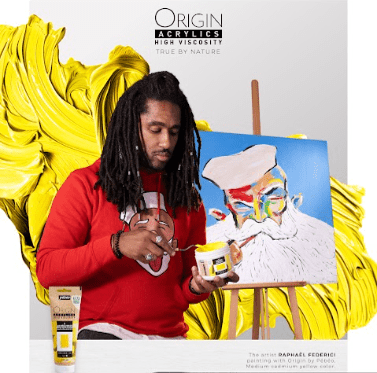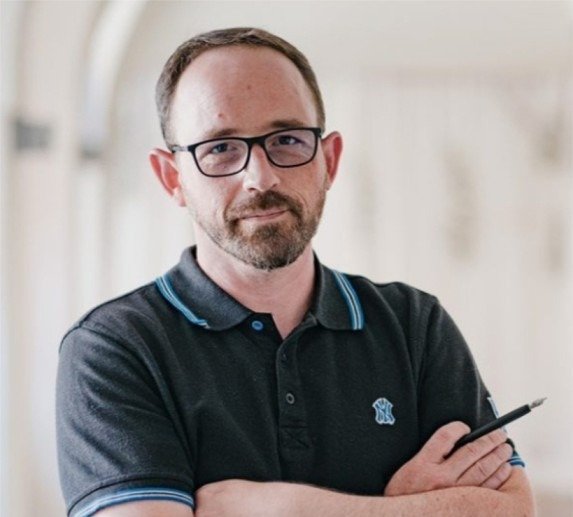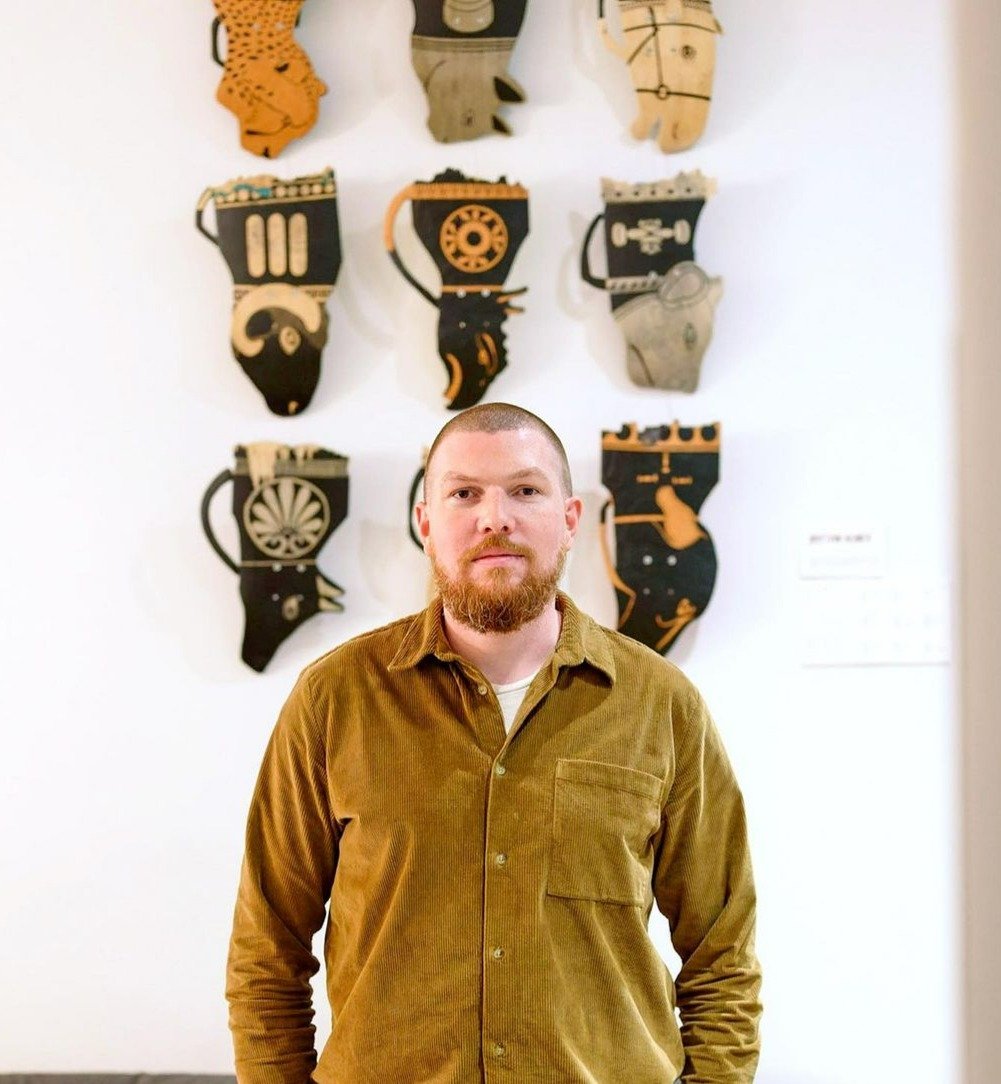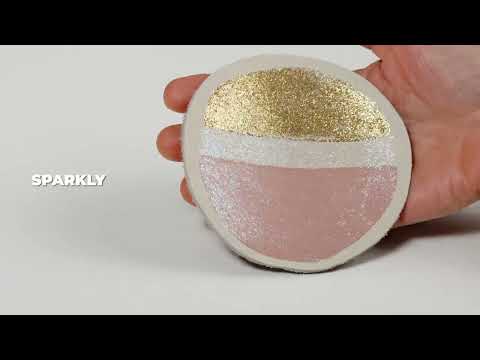DANIEL BUREN: ENTRETIEN EXCLUSIF SUR LE THÈME DE LA COULEUR
28/04/2021
Daniel Buren ne laisse jamais indifférent. Après Kiefer, Serra, Boltanski et Kapoor, cette année, l’artiste des vastes espaces publics a apprivoisé le Grand Palais. Il est aussi le maître, le théoricien, l’enseignant. Rencontre exceptionnelle avec Buren sur son intervention toujours in-situ et comment il définit la couleur .
BEAUCOUP DE PERSONNES CONNAISSENT, DE PRÈS OU DE LOIN, VOTRE TRAVAIL ET VOUS COMPTEZ PARMI LES ARTISTES FRANÇAIS LES PLUS RECONNUS AUJOURD’HUI. VOUS ÊTES TRÈS TÔT ENTRÉ DANS UNE DYNAMIQUE DE TRAVAIL DIT «IN SITU», DONT LA MENTION ACCOMPAGNE TOUJOURS L’ŒUVRE EN SOUS-TITRE. QU’EST-CE QUI VOUS A POUSSÉ VERS CETTE DÉMARCHE?
Il est toujours assez difficile de savoir exactement comment l’on arrive à telle ou telle position, voire décision. Je pense qu’il s’agissait d’un long mûrissement où, confusément, je ressentais des “manques” dans les œuvres, manques que je cherchais par tous les moyens à combler. J’avais, très jeune, été assez choqué par le fait que toutes les qualités que je trouvais dans les œuvres des artistes en parlant directement avec eux dans leur atelier, entourés par leurs propres travaux, disparaissaient en partie lorsque ces mêmes œuvres se retrouvaient accrochées aux cimaises des galeries qui les exposaient. Pour moi, un glissement se produisait alors et je ne comprenais pas de quel ordre il était. J’avais 17 ans et j’avais rencontré des cinquantaines d’artistes, des plus fameux comme Picasso, Chagall, Masson et bien d’autres jusqu’à d’illustres inconnus. À chaque fois, avec plus ou moins d’envergure, une grande partie des qualités que je trouvais dans leurs œuvres, disparaissait avec ce “transport” du lieu de fabrication au lieu d’exposition. Je pense que cette sensation qui s’est accentuée avec le temps m’a poussé petit à petit à abandonner l’idée de travailler dans un atelier, puis m’a mis en face de solutions radicales, comme par exemple: “quoi faire si un peintre n’a plus d’atelier ?”, d’où ma bascule dans la rue directement pour travailler et donc à la notion de garder cette attitude de travail, aussi longtemps que possible, et d’apprendre à travailler par rapport et dans un lieu spécifique à chaque fois au fur et à mesure que mon travail avançait. Je suis encore aujourd’hui dans l’expérimentation provoquée par cette attitude d’un travail vite définit comme “in situ” dès le début des années 70.
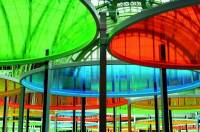
POUR L’OEUVRE «LES DEUX PLATEAUX, TRAVAIL IN SITU PERMANENT» DE 1985-1986, DANS LA COUR D’HONNEUR DU PALAIS-ROYAL DE PARIS, QUE TOUT LE MONDE CONNAÎT SOUS LE NOM DES «COLONNES DE BUREN», VOUS UTILISEZ VOS RAYURES DE 8,7CM DE LARGE, COMME UN OUTIL VISUEL. POURQUOI AVEZ VOUS UTILISÉ LE NOIR ET BLANC?
La notion d’ “outil visuel” est arrivée un peu plus tard, mais ici au Palais Royal, la raison de l’utilisation des couleurs noire et blanche est principalement due aux croisements de l’étude du lieu, du climat et des matériaux disponibles. Cette étude me fit procéder par élimination. Au départ, j’aurais aimé utiliser non seulement des bandes colorées comme le vert, le rose ou le rouge mais également un sol coloré. À l’étude des matériaux disponibles, aucun - à l’exception de matériaux plastiques moins que sûrs, ou de céramiques que je ne voulais pas - n’existait, qui résiste sérieusement au temps sous le climat d’une ville comme Paris. Les seuls matériaux convenables et relativement stables dans le temps étaient bien entendu ceux qui constituent en majorité la ville elle-même à savoir la pierre, le marbre, le granit, le ciment, l’asphalte, le zinc, l’eau etc... Quels marbres résistent à la pollution par exemple ? On peut en trouver de magnifiques, bleus, roses, rouges, verts et autres couleurs, ils n’ont qu’un seul défaut: au bout de 6 à dix mois dehors aux vents et à la pluie, ils se décolorent et on tendance à devenir tous assez homogène, c’est-à-dire, gris. Le seul à perdre également son éclat mais à ne pas trop changer de couleur étant le marbre (ou le granit) noir qui, lorsqu’il pâlit, devient gris foncé. De même avec l’asphalte qui passe du noir au gris après une petite année. Je pensais donc que la “perte” colorée de noir à gris foncé était bien plus acceptable visuellement parlant que la perte d’un rouge ou d’un vert qui aurait donné une allure très particulière à l’ensemble, vite contrariée par un amoindrissement où toute idée de la couleur d’origine aurait disparue. J’optais donc pour le noir et le blanc et les matériaux les plus stables à savoir l’asphalte, le ciment, le granit, le marbre (blanc et noir), les grilles (gris foncé). On prendra également en compte que, même après une année de décoloration systématique, ici de perte de contraste, la moindre pluie - ce qui n’est pas rare à Paris! - redonne à tout l’ensemble sa brillance et ses couleurs d’origine. Voilà pourquoi ces couleurs et pas d’autres. Cependant, la nuit, la pièce se transforme et c’est une œuvre colorée, bleue, verte et rouge qui prend place.
QU’EST-CE QUI PERMET, SELON VOUS, DE DÉFINIR UNE COULEUR?
Les paramètres sont nombreux. Le tout dernier - celui dont il faut absolument se méfier - c’est son propre goût en la matière. Ceux qui comptent sont, par exemple, la manière dont certaines couleurs sont perçues dans telle ou telle culture. Par exemple, au Japon, des bandes alternées blanches et noires ou bien blanches et violettes sont les signes et les couleurs du deuil. Tout le monde, immédiatement, les lit dans ce sens-là. Si donc j’utilise ces deux couleurs dans un travail et que je n’ai aucune intention de faire une allusion quelconque au deuil ou à la mort, tout mon travail sera lu d’une manière totalement autre que celle à laquelle je pouvais penser. Un tel travail se trouverait alors chargé très fortement d’un sens auquel il ne pourrait échapper tout en lui étant complètement étranger. La connaissance d’un tel fait va donc permettre d’éliminer (ou d’accepter) ce signe et ces couleurs en connaissance de cause et éviter ainsi de possibles contre-sens. Les paramètres de ce genre, plus ou moins aigus, sont légions. Voilà les paramètres qui m’intéressent beaucoup plus que d’autres qui nous disent que le rouge excite et que le bleu apaiserait par exemple. Même si il y a quelque justesse dans ce type de rapports physiologiques, ils ne m’intéressent pas au premier chef.

VOUS UTILISEZ À DE NOMBREUSES REPRISES DES FILTRES COLORÉS DANS VOS DISPOSITIFS, POURQUOI CE SUPPORT EN PARTICULIER?
Ils permettent à la couleur de se projeter et de venir ainsi colorer, d’une manière très spéciale, tout ce qu’elle touche. La transparence et la qualité d’une couleur projetée grâce à un filtre coloré est, à mes yeux, beaucoup plus vivante qu’une couleur peinte, recouvrant une surface. Le dialogue entre ces deux manières d’utiliser la couleur dans un même lieu, par exemple, est extrêmement riche.
COMMENT DÉFINIRIEZ-VOUS LE RÔLE OU LA FONCTION DE LA COULEUR DANS VOTRE EXPOSITION «EXCENTRIQUE(S), TRAVAIL IN SITU» POUR MONUMENTA 2012 AU GRAND PALAIS ?
Elle a ici, il me semble, le rôle principal. Elle passe constamment selon les caprices du soleil et des nuages, de l’état de saupoudrage du sol à celui d’impressions quasi photographiques venant s’imprimer directement et sur celui-ci principalement, mais également sur tout ce sur quoi ces projections colorées vont venir toucher (les montants verticaux, les murs, les parois, les gens...).
VOUS AVEZ MENTIONNÉ UN NON CHOIX DES COLORIS POUR LES FILTRES DE COULEURS EMPLOYÉS DANS CE DISPOSITIF, QUELLE EST VOTRE POSITION VIS-À-VIS DE CELA ET POURQUOI?
Ma position est fort simple et souvent utilisée depuis plus de quarante ans. J’utilise ce qui m’est proposé ou bien ce que j’arrive à trouver. Justement, dans ces cas, tous les rapports que ces couleurs vont pouvoir créer ensemble ici principalement grâce aux jeux incessants et multiples de l’ombre et de la lumière, ne sont pas dûs à un choix spécifique dont l’artiste serait le démiurge mais bien au jeu fantastique et unique créé, hors du goût de l’artiste/auteur, par le dire intrinsèque des couleurs en questions qui se trouvent ici, pourrait-on dire, par la force des choses (leur fabrication, leurs obligations chimiques, le choix de l’entreprise...).

QUELLE COULEUR VOUS TOUCHE LE PLUS, ET POURQUOI?
Aucune en particulier. C’est-à-dire chacune en particulier.
Produits Connexes
à lire aussi
@PEBEO Suivre Pébéo sur Instagram
Newsletter
Inscrivez-vous à notre Newsletter et restez informé de nos actualités. Pour en savoir plus sur la gestion de vos doneés personnelles et pour exercer vos droits, cliquez, ici
